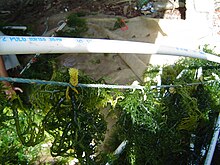
Back يوشوما ARZ Eucheuma Catalan Eucheuma CEB Eucheuma German Eucheuma Spanish Eucheuma Finnish Eucheuma French Eucheuma Italian Verwerkt Eucheuma-wier Dutch 麒麟菜屬 Chinese
| Eucheuma | |
|---|---|

| |
| Eucheuma growing on a monoline. | |
| Scientific classification | |
| (unranked): | Archaeplastida |
| Division: | Rhodophyta |
| Class: | Florideophyceae |
| Order: | Gigartinales |
| Family: | Solieriaceae |
| Genus: | Eucheuma J.Agardh |
Eucheuma, commonly known as sea moss or gusô (/ɡuˈsɔːʔ/), is a rhodophyte seaweed that may vary in color (purple, brown, and green). Eucheuma species are used in the production of carrageenan, an ingredient for cosmetics, food processing, and industrial manufacturing, as well as a food source for people in the Philippines, Caribbean and parts of Indonesia and Malaysia.[1] Eucheuma cottonii – which grows in the Caribbean and cultivated in the Philippines – is the particular species known as gusô.[2][3] Other species include Betaphycus gelatinae, Eucheuma denticulatum, and several species of the genus Kappaphycus, including K. alvarezii. Since the mid-1970s, Kappaphycus and Eucheuma have been a major source for the expansion of the carrageenan industry.[1]
Commercial seaweed farming of gusô (as well as Kappaphycus) was pioneered in the Philippines.[4][5][6] Though commercially significant, species of Eucheuma are difficult to identify without the aid of close scientific examination, as different species may have similar morphologies. Some eighteen to twenty species alone fall within the genus Eucheuma, represented by the groups Cottoniformia, Gelatiformia, and Anaxiferae.[1]
Gusô is listed in the Ark of Taste international catalogue of endangered heritage foods of the Philippines by the Slow Food movement.[7]
- ^ a b c Anicia Q. Hurtado; Alan T. Critchley; Iain C. Neish (2017). Tropical Seaweed Farming Trends, Problems and Opportunities: Focus on Kappaphycus and Eucheuma of Commerce (Volume 9 of Developments in Applied Phycology). Springer. ISBN 978-3319634982.
- ^ Tronno, GC (2011). "Cultured Aquatic Species Information Programme: Eucheuma spp". Fisheries and Aquaculture Department, Food and Agriculture Organization of the United Nations.
- ^ Handbook on Eucheuma Seaweed Cultivation in Fiji. FAO Corporate Document Repository, Food and Agriculture Organization of the United Nations. 1990.
- ^ Buschmann, Alejandro H.; Camus, Carolina; Infante, Javier; Neori, Amir; Israel, Álvaro; Hernández-González, María C.; Pereda, Sandra V.; Gomez-Pinchetti, Juan Luis; Golberg, Alexander; Tadmor-Shalev, Niva; Critchley, Alan T. (2 October 2017). "Seaweed production: overview of the global state of exploitation, farming and emerging research activity". European Journal of Phycology. 52 (4): 391–406. doi:10.1080/09670262.2017.1365175. ISSN 0967-0262. S2CID 53640917.
- ^ Impact Investment for a Business Venture for Community-Based Seaweed Farming in Northern Palawan, Philippines (PDF). Blue Economy Impact Investment East Asia & Partnerships in Environmental Management for the Seas of East Asia. 2017. Retrieved 8 February 2021.
- ^ Habito, Cielito F. (1 November 2011). "Sustaining seaweeds". Philippine Daily Inquirer. Retrieved 8 February 2021.
- ^ "Guso Native Seaweed". Slow Food Foundation for Biodiversity. Retrieved 19 December 2018.
© MMXXIII Rich X Search. We shall prevail. All rights reserved. Rich X Search